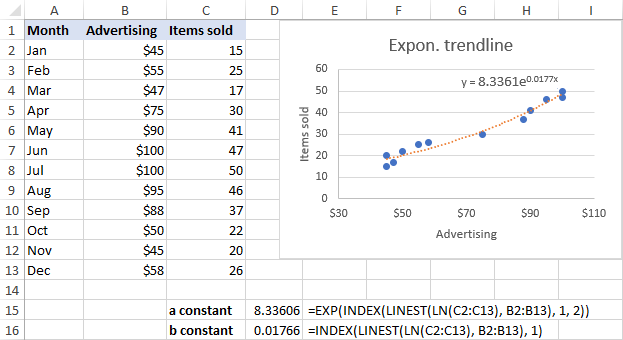
- Trendline for selected data points excel mac how to#
- Trendline for selected data points excel mac manual#
- Trendline for selected data points excel mac plus#
- Trendline for selected data points excel mac professional#
You could do this directly from the graph, of course, but selecting things from graphs can be tricky at times. You can now see the equation and have enough significant figures so you can use the coefficients.Īnother little trick you can use to see the coefficients properly is to select the equation on the graph, drag your mouse over the equation to select it as text, then Copy it, and Paste it into a convenient cell where you can easily copy and paste individual coefficients.

Click on the equation on the chart to select it, then choose Format/Selected Data Labels.įrom the window that appears, make the Font size 10 or 12 so you can see it, then click the Number tab and set Scientific Notation with three places after the decimal. (1) It is too small to see properly, and (2) the coefficients don't have enough significant figures for accurate use. The equation we get on the chart needs to be fixed up a bit before we can use it. Under Options, choose Display Equation on Chart

From the window that appears, select Polynomial of Order 2. From the menu choose Chart/Add Trendline. Graph the data using a Scatter (XY) plot in the usual way. How do we do our second order fit using Excel? This tells us that doing a second order fit on these data should be professionally acceptable.
Trendline for selected data points excel mac manual#
Our results show (1.07/9.19)*100 = 12%.Ģ) We have been warned that at moderately high absorbance values we might get non-linearity when doing atomic absorption.ģ) Consulting the manual for our atomic absorption spectrometer, we find that it has built-in software for a "three-point calibration." Three points are the minimum needed to do a curved, second-order fit.
Trendline for selected data points excel mac professional#
Instead, we must rely on what a professional chemist would expect to see.ġ) We expect the error for this method to be around 1 or 2%. There is no reliable formula or computer analysis that can tell the difference between scattered data and curved data when the number of data points is small. How do we know that this is a poor choice? Do the data really have the amount of scatter shown? Shouldn't we just accept the value of 9.19 +or- 1.07 µg/mL? These questions do not have obvious answers. In the example above we see a standard LLS first order fit.
Trendline for selected data points excel mac plus#
Note that you can also use the plus icon to enable and disable the trendline.A First Order Fit to the data used to construct a working curve follows the equation:įailure to check our data for linearity before performing our usual Linear Least Squares (LLS) analysis will generate a large error if the data are curved rather than straight. The data shows a strong linear relationship between height and weight. Right click any data point, then select "Add trendline".Įxcel adds a linear trendline, which works fine for this data. Trendlines help make the relationship between the two variables clear. If you want a little more white space in the vertical axis, you can reduce the plot area, then drag the axis title to the left. Select the title, type an equal sign, and click a cell.

Just like the chart title, we already have titles on the worksheet that we can use, so I'm going to follow the same process to pull these labels into the chart. While I'm here I'm also going to remove the gridlines. Just select the chart, click the plus icon, and check the checkbox. The easiest way to do this is to use the plus icon. Notice the horizontal axis scale was already adjusted by Excel automatically to fit the data. I'll double click the axis, and set the minimum to 100. To help make the relationship between height and weight clear, I'm going to set the lower bound to 100. Next let's adjust the vertical axis scale. Just select the title, type an equal sign, and click the cell. Now, since we already have a decent title in cell B3, I'll use that in the chart. X values come from column C and the Y values come from column D. Here you can see there is one data series. Let's check Select Data to see how the chart is set up. When I click the mouse, Excel builds the chart.

The first preview shows what we want - this chart shows markers only, plotted with height on the horizontal axis and weight on the vertical axis. Here I'll select all data for height and weight, then click the scatter icon next to recommended charts. When creating scatter charts, it's generally best to select only the X and Y values, to avoid confusing Excel. Let's create a scatter plot to show how height and weight are related. On this worksheet, we have the height and weight for 10 high school football players. A scatter chart has a horizontal and vertical axis, and both axes are value axes designed to plot numeric data.
Trendline for selected data points excel mac how to#
In this video, we'll look at how to create a scatter plot, sometimes called an XY scatter chart, in Excel.Ī scatter plot or scatter chart is a chart used to show the relationship between two quantitative variables.


 0 kommentar(er)
0 kommentar(er)
